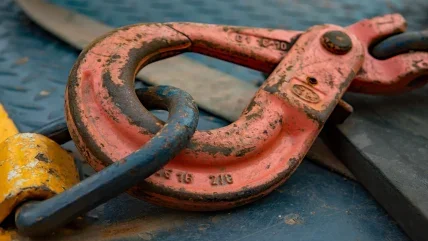
Subsea rigging gear has been used in the offshore sector for several decades, especially since there has been oil and gas drilling.
The use of rigging products, such as lifting slings, shackles, hooks, among other equipment, is essential for the safe and efficient handling of heavy loads in underwater operations.
The maritime and offshore sector places great demands on these products and the people that use, maintain and inspect them. End users have to achieve safe, precise lifting and lowering of loads under seawater, sometimes to depths of up to 3,000m, despite extreme ambient conditions, waves, unpredictable currents, and poor lighting. Further, salt water is omnipresent and time windows to complete work are often small.
Remotely operated vehicles (ROVs) are unoccupied, highly manoeuvrable underwater machines that can be used to explore ocean depths, while being controlled by someone at the water surface. They are complex and serve various purposes, from exploration and unmanned expeditions to research and sporting events. They are used by scientists, zoologists and botanists. Many industries, like aquaculture, use these devices for infrastructure inspections and repairs.
When there is a need to handle subsea equipment, special tooling is required. Certain hooks are developed especially for operation by an ROV manipulator; they provide a secure attachment and ensure that the loads remain stable during lifting operations.
On deck, they can be operated by hand, but underwater, there are four common scenarios where they are integral to material handling processes:
1. Raising and lowering equipment: Hooks are commonly used to hoist and lower heavy loads such as subsea cables, pipelines, structures or equipment components. They provide a secure attachment and ensure that the loads remain stable during transport or installation.
2. Securing subsea structures: Lifting accessories play a crucial role in securing subsea structures like platforms, pipelines or anchor lines. They are used to fasten the structures and protect them from movements or damage caused by ocean currents, waves or other external forces.
3. Connecting components: During the installation or maintenance of subsea equipment, lifting accessories are used to connect various components. This may involve joining cables, pipes, anchoring systems or brackets to create a stable and reliable structure.
4. Salvage operations: Accessories are often used in subsea salvage operations. They facilitate the safe lifting of sunken vessels or securing of wreckage pieces.
LOSING SNAGS, NOT LOADS
Caldwell’s ROV hook entered production nearly a decade ago. Two of the issues end users must avoid are unintentional opening of the hook and snagging on protruding parts. The latest products boast an ability to open and close the safety latch by a single ROV manipulator, counteracting the issues of shedding and jamming, while double safety latches are also available. The 10t capacity RUD ROV hook weighs 13.5kg; the 25t version, 26kg. The first is 55mm in height and the second, 92mm.
Thanks to the spring-supported series connection, these hooks only open when both triggers are actuated at the same time. Unintentional opening of the hook is also impossible because the outwardly opening safety latch automatically closes when the ROV releases the triggers, and the safety latch is securely locked in a closed position. The outer profile is smooth with no protruding hook nose.
The RUD version offers a 4:1 design factor, it is 100% crack tested, and it is easy to repair, utilising spare parts sets with screws, compression springs, triggers and safety latches.






